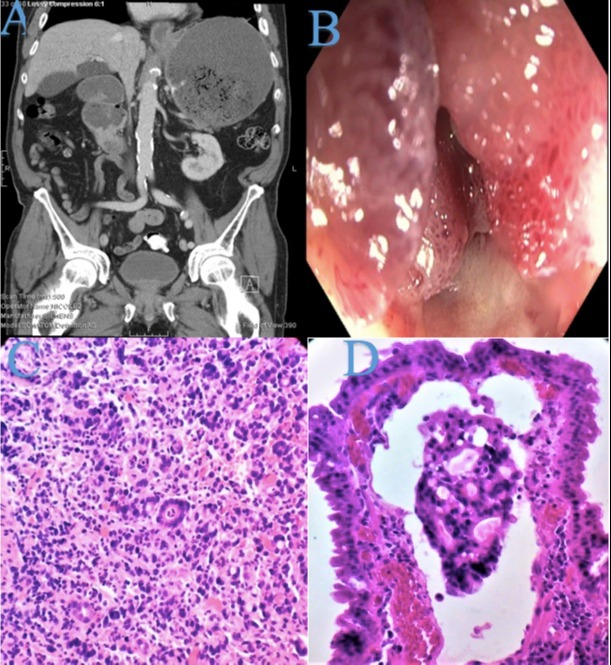Back


Poster Session C - Monday Afternoon
Category: Stomach
C0716 - Gastric Outlet Obstruction as a Presenting Symptom of Duodenal Adenocarcinoma
Monday, October 24, 2022
3:00 PM – 5:00 PM ET
Location: Crown Ballroom

Has Audio

Erika Vigandt, MD
The Brooklyn Hospital Center
Brooklyn, NY
Presenting Author(s)
Erika Vigandt, MD1, Vijay Gayam, MD1, Praneeth Bandaru, MD1, Srilaxmi Gujjula, MD1, Suut Gokturk, MD1, Aditya Chauhan, MD1, Vikash Kumar, MD1, Kimberly Geckle, APRN-CNP2, Andrew Popp, MD2, Heidi Budke, MD2, Vinaya Gaduputi, MD, FACG2
1The Brooklyn Hospital Center, Brooklyn, NY; 2Blanchard Valley Health System, Findlay, OH
Introduction: Gastric outlet obstruction (GOO) can be due to benign or malignant causes. Benign etiologies of GOO have been down-trending, resulting in 50-80% of cases of GOO attributable to malignancy. Of the malignant causes leading to GOO, pancreatic adenocarcinoma with extension to the duodenum or stomach is the most common cause, followed by distal gastric cancer. However, primary duodenal adenocarcinoma as the cause of GOO is relatively rare, and we present a case of moderate to poorly differentiated duodenal adenocarcinoma leading to GOO.
Case Description/Methods: An 82-year-old man with no reported past medical history presented to the hospital with epigastric abdominal pain associated with worsening distention, nausea, multiple episodes of non-bloody projectile vomiting, and associated weight loss of 12 pounds in the past 2 months. The abdominal exam was unremarkable. Labs were nonsignificant. A computer tomography (CT) scan of the abdomen and pelvis revealed a massively dilated stomach with suspected circumferential narrowing in the distal stomach suggestive of gastric outlet obstruction (Fig.1 A). NGT was placed for decompression, with significant relief of symptoms. The patient underwent EGD, and no gross mass or obstructive etiology was noted in the entire stomach, including pylorus and antrum. There was inflammatory appearing mucosa characterized by extensive edema and contact oozing resulting in mass effect with severe luminal narrowing in the duodenal sweep/D2 regions (Fig. 1 B). Biopsies were obtained and showed moderate to poorly differentiated adenocarcinoma (Fig. 1 C, D). Subsequently patient underwent palliative duodenal stent placement with symptomatic relief.
Discussion: Clinical history is important in suspecting the diagnosis of GOO. Cross-sectional imaging aids in diagnosis but sometimes does not help differentiate benign vs. malignant etiologies. EGD is helpful when imaging is inconclusive and for definitive pathological diagnosis. Most patients achieve symptomatic relief with conservative measures like NPO and NGT decompression. The definitive treatment for GOO varies based on etiology. Most patients with malignant causes need surgery for a cure if suitable candidates. Until recently, surgical gastrojejunostomy was the primary approach for palliative purposes. However, duodenal stent placement has become the primary palliative option as it is a cost-effective, minimally invasive option with adequate symptom relief, shortened hospital stay, and faster resumption of oral intake.

Disclosures:
Erika Vigandt, MD1, Vijay Gayam, MD1, Praneeth Bandaru, MD1, Srilaxmi Gujjula, MD1, Suut Gokturk, MD1, Aditya Chauhan, MD1, Vikash Kumar, MD1, Kimberly Geckle, APRN-CNP2, Andrew Popp, MD2, Heidi Budke, MD2, Vinaya Gaduputi, MD, FACG2. C0716 - Gastric Outlet Obstruction as a Presenting Symptom of Duodenal Adenocarcinoma, ACG 2022 Annual Scientific Meeting Abstracts. Charlotte, NC: American College of Gastroenterology.
1The Brooklyn Hospital Center, Brooklyn, NY; 2Blanchard Valley Health System, Findlay, OH
Introduction: Gastric outlet obstruction (GOO) can be due to benign or malignant causes. Benign etiologies of GOO have been down-trending, resulting in 50-80% of cases of GOO attributable to malignancy. Of the malignant causes leading to GOO, pancreatic adenocarcinoma with extension to the duodenum or stomach is the most common cause, followed by distal gastric cancer. However, primary duodenal adenocarcinoma as the cause of GOO is relatively rare, and we present a case of moderate to poorly differentiated duodenal adenocarcinoma leading to GOO.
Case Description/Methods: An 82-year-old man with no reported past medical history presented to the hospital with epigastric abdominal pain associated with worsening distention, nausea, multiple episodes of non-bloody projectile vomiting, and associated weight loss of 12 pounds in the past 2 months. The abdominal exam was unremarkable. Labs were nonsignificant. A computer tomography (CT) scan of the abdomen and pelvis revealed a massively dilated stomach with suspected circumferential narrowing in the distal stomach suggestive of gastric outlet obstruction (Fig.1 A). NGT was placed for decompression, with significant relief of symptoms. The patient underwent EGD, and no gross mass or obstructive etiology was noted in the entire stomach, including pylorus and antrum. There was inflammatory appearing mucosa characterized by extensive edema and contact oozing resulting in mass effect with severe luminal narrowing in the duodenal sweep/D2 regions (Fig. 1 B). Biopsies were obtained and showed moderate to poorly differentiated adenocarcinoma (Fig. 1 C, D). Subsequently patient underwent palliative duodenal stent placement with symptomatic relief.
Discussion: Clinical history is important in suspecting the diagnosis of GOO. Cross-sectional imaging aids in diagnosis but sometimes does not help differentiate benign vs. malignant etiologies. EGD is helpful when imaging is inconclusive and for definitive pathological diagnosis. Most patients achieve symptomatic relief with conservative measures like NPO and NGT decompression. The definitive treatment for GOO varies based on etiology. Most patients with malignant causes need surgery for a cure if suitable candidates. Until recently, surgical gastrojejunostomy was the primary approach for palliative purposes. However, duodenal stent placement has become the primary palliative option as it is a cost-effective, minimally invasive option with adequate symptom relief, shortened hospital stay, and faster resumption of oral intake.

Figure: Figure 1.
A: CT abdomen/pelvis showed massively dilated stomach with suspected circumferential narrowing in the distal stomach suggestive of gastric outlet obstruction. Circumferential thickening and narrowing of the descending duodenum.
B: EGD revealing inflammatory appearing mucosa with extensive edema and contact oozing resulting in mass effect with severe luminal narrowing in the duodenal sweep/D2 regions.
C: Immunohistochemistry/histology of biopsies obtained during EGD revealing duodenal adenocarcinoma with tumor glands.
D: Tumor emboli in the lymphatics of the duodenal villi.
A: CT abdomen/pelvis showed massively dilated stomach with suspected circumferential narrowing in the distal stomach suggestive of gastric outlet obstruction. Circumferential thickening and narrowing of the descending duodenum.
B: EGD revealing inflammatory appearing mucosa with extensive edema and contact oozing resulting in mass effect with severe luminal narrowing in the duodenal sweep/D2 regions.
C: Immunohistochemistry/histology of biopsies obtained during EGD revealing duodenal adenocarcinoma with tumor glands.
D: Tumor emboli in the lymphatics of the duodenal villi.
Disclosures:
Erika Vigandt indicated no relevant financial relationships.
Vijay Gayam indicated no relevant financial relationships.
Praneeth Bandaru indicated no relevant financial relationships.
Srilaxmi Gujjula indicated no relevant financial relationships.
Suut Gokturk indicated no relevant financial relationships.
Aditya Chauhan indicated no relevant financial relationships.
Vikash Kumar indicated no relevant financial relationships.
Kimberly Geckle indicated no relevant financial relationships.
Andrew Popp indicated no relevant financial relationships.
Heidi Budke indicated no relevant financial relationships.
Vinaya Gaduputi indicated no relevant financial relationships.
Erika Vigandt, MD1, Vijay Gayam, MD1, Praneeth Bandaru, MD1, Srilaxmi Gujjula, MD1, Suut Gokturk, MD1, Aditya Chauhan, MD1, Vikash Kumar, MD1, Kimberly Geckle, APRN-CNP2, Andrew Popp, MD2, Heidi Budke, MD2, Vinaya Gaduputi, MD, FACG2. C0716 - Gastric Outlet Obstruction as a Presenting Symptom of Duodenal Adenocarcinoma, ACG 2022 Annual Scientific Meeting Abstracts. Charlotte, NC: American College of Gastroenterology.
